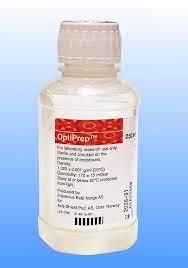OptiPrep™ Application Sheet S29

OptiPrep™
Fractionation of apical and basolateral plasma membrane domains fromCaco-2 cells
Fractionation of apical and basolateral plasma membrane domains fromCaco-2 cells
♦ OptiPrep™ is a 60% (w/v) solution of iodixanol in water, density = 1.32 g/ml.
♦ To access other Application Sheets referred to in the text: return to the 2020SMemapp file andselect the appropriate S-number.
♦ Important technical notes, information regarding alternative methodologies and membrane analysis are contained in the “Technical Notes and Review” section (Section 5)
1. Background
The resolution of plasma membrane (PM) domains, primarily the basolateral and apical domainsfrom polarized tissues such as intestine, liver and kidney and also from polarized cells such as humancolon adenocarcinoma (Caco-2) cells and Madin-Darby canine kidney (MDCK) cells, is an importantpreliminary requirement for studies on how functional dichotomy at the cell surface is achieved.Methods often involve the use of divalent cations.
Brush border preparations, from for exampleintestinal mucosa, treated with 10 mM MgSO4, allow residual basolateral membrane and intracellularmembranes to be removed by low-speed centrifugation [1]. Ellis et al [2] used a modification of thisprocedure; basolateral and apical membranes from Caco-2 cells were separated in a sucrose gradientand 10 mM MgCl2 was used to remove contaminating intracellular membranes from the basolateraldomain band.Iodixanol gradients are however now being increasingly used to provide the high resolutionnecessary to purify both the apical and basolateral membranes away from other intracellularmembranes.
This Application Sheet describes the use of CaCl2 to separate the apical domain from thebasolateral domain + endomembranes from a post-mitochondrial supernatant of Caco-2 cells and thensubsequently an iodixanol gradient to resolve the basolateral domain from endomembranes
[3]. Methods for the resolution of some other plasma membrane domains may be accessed via the Index.
2. Solutions required (see Section 5.1)A. OptiPrep™B. Phosphate-buffered saline (PBS)C. Homogenization buffer:
3 mM EDTA, 10 mMTris-HCl, pH 7.4D. OptiPrep™ dilution buffer: 18 mM EDTA, 60 mMTris-HCl, pH 7.
4E. Working Solution (50% w/v iodixanol): mix 5 vol.of Optiprep™ with 1 vol. of Solution DF. Ca2+ solution: 100 mM CaCl23. Ultracentrifuge rotor requirements (see Section 5.2)
Swinging-bucket rotor with 13-14 ml tubes (e.g. Beckman SW41Ti, Sorvall TH641 or similar)
4. Protocol (adapted from ref 3) Carry out all operations except Step 1 at 0-4°C. 1. Grow Caco-2 cells on permeable supports as required.
2. Scrape off the cells from the filter using a policeman into ice-cold PBS.3. Pellet the cells at 600 g for 10 min (or 20 sec in a microfuge) and wash the cells once with PBS.